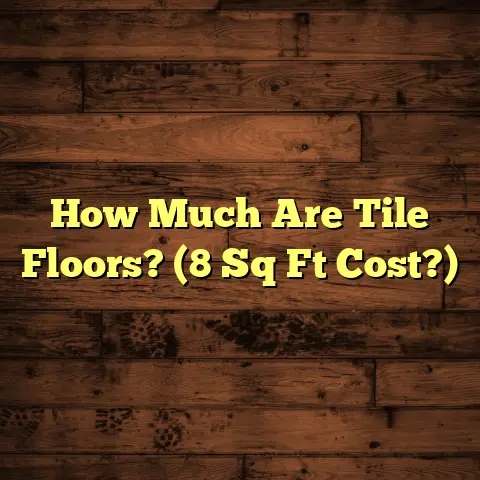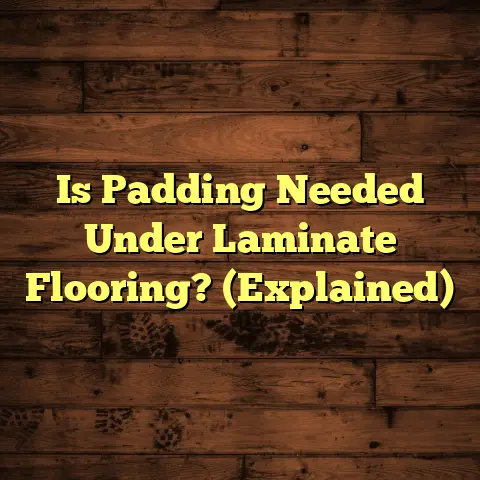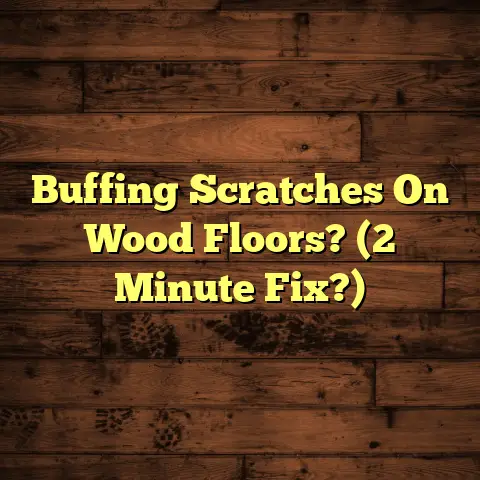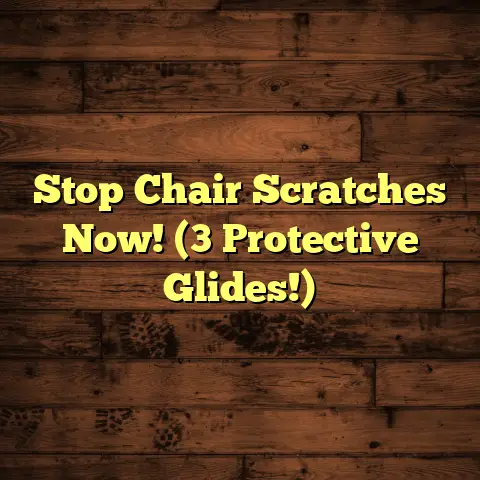Floor Removal In Necesse: How-To? (5 Crucial Steps)
Have you ever walked into a room and felt that the flooring just didn’t match your taste or the ambiance you were trying to create? I know I have!
Sometimes, it’s like the flooring is screaming the wrong message.
Introduction: Why Floor Removal Matters
Flooring is more than just something you walk on; it’s a foundational element of your home or business. Think about it: the right flooring can completely transform a space, enhancing its aesthetics, comfort, and functionality.
A beautiful hardwood floor can add warmth and elegance, while durable tile is perfect for high-traffic areas. But what happens when your current flooring just isn’t cutting it anymore?
That’s where floor removal comes in. It’s a necessary step when upgrading or changing flooring types to better suit your preferences and needs.
In this article, I’m going to walk you through five crucial steps to successfully remove flooring in a place like Necesse. Whether you’re dealing with old carpet, outdated tile, or worn-out laminate, I’ll provide you with the knowledge and guidance you need to ensure a smooth transition to new floor installation.
Let’s get started!
Step 1: Assessing the Current Flooring
Before you start swinging a hammer or prying up boards, it’s crucial to understand what you’re dealing with. I always tell my clients, “Know thy enemy… err, I mean, thy flooring!”
The first step is to evaluate the type of flooring currently in place. Is it tile, hardwood, carpet, or laminate? Determining the flooring material is significant because it directly influences the tools and methods required for removal.
-
Carpet: Usually easy to spot, but check for padding underneath.
-
Tile: Hard, often with grout lines. Could be ceramic, porcelain, or stone.
-
Hardwood: Solid wood planks, often nailed or glued down.
-
Laminate: A synthetic material that mimics wood or tile.
Why does this matter? Well, removing carpet requires a utility knife and some muscle, while tile might need a hammer, chisel, and a whole lot of patience.
Also, take a good look for signs of damage or wear that may prompt removal. Are there buckling boards, unsightly stains, or excessive wear in high-traffic areas? These issues not only detract from the appearance of your space but can also indicate underlying problems like moisture damage.
I remember one job in Necesse where the client wanted to replace their kitchen tile. Upon closer inspection, we found significant water damage underneath, which had caused the tile to crack. Addressing that underlying issue was just as important as removing the old tile.
Step 2: Preparing the Workspace
Okay, you know what you’re dealing with. Now it’s time to prep the battlefield.
Proper preparation is essential for a safe and effective removal process. I can’t stress this enough: take the time to do this right, and you’ll save yourself headaches (and maybe injuries) down the road.
Here’s what I usually do:
-
Clear the area: Remove all furniture, rugs, and belongings from the room. This gives you plenty of space to work and prevents damage to your valuables.
-
Protect adjacent areas: Cover doorways and vents with plastic sheeting to contain dust and debris. Trust me, you don’t want that stuff spreading throughout your house.
-
Secure the workspace: Use painter’s tape to secure the edges of the plastic sheeting and prevent tripping hazards.
-
Safety first: This is huge! Always wear appropriate safety gear. I’m talking gloves, goggles, and a mask. Floor removal can generate a lot of dust and debris, and you don’t want to breathe that in or get it in your eyes.
-
Gloves: Protect your hands from sharp objects and adhesives.
-
Goggles: Shield your eyes from flying debris.
-
Mask: Prevent inhalation of dust and mold spores.
-
I once skipped the mask while removing some old carpet, and I regretted it for days. My sinuses were not happy!
Step 3: Gathering the Right Tools and Materials
Alright, you’ve assessed the flooring and prepped the workspace. Now it’s time to gather your arsenal. Having the right tools and materials on hand will make the removal process much smoother and more efficient.
Here’s a comprehensive list of tools you might need, depending on the type of flooring you’re removing:
-
Pry bar: For lifting and prying up flooring materials.
-
Utility knife: For cutting carpet, vinyl, and other flexible materials.
-
Hammer: For striking chisels and flooring scrapers.
-
Flooring scraper: For removing adhesive residue and stubborn flooring.
-
Crowbar: A larger pry bar for heavy-duty lifting.
-
Chisel: For breaking up tile and removing stubborn adhesives.
-
Gloves: Protect your hands from sharp objects and chemicals.
-
Safety goggles: Protect your eyes from flying debris.
-
Dust mask: Protect your lungs from dust and mold spores.
-
Trash bags: For disposing of debris. Heavy-duty ones are a must!
-
Floor protectors: To avoid damage to the subfloor.
-
Shop vacuum: For cleaning up dust and debris.
Where can you acquire these tools in Necesse? I recommend checking out:
-
Local hardware stores: Places like “Necesse Hardware” or “Main Street Supply” usually have a good selection of tools and materials.
-
Rental services: If you only need a specific tool for a one-time job, consider renting it from a place like “Rent-A-Tool.”
-
Online retailers: Amazon and other online retailers can be a convenient option, but make sure to factor in shipping time.
Pro tip: Don’t skimp on quality! Investing in good-quality tools will not only make the job easier but also ensure that they last for future projects.
Step 4: Executing the Removal Process
Okay, this is where the fun (or the frustration) begins! Now it’s time to put those tools to work and start removing the old flooring. I’m going to break down the process for different types of flooring, so you know exactly what to expect.
Removing Carpet and Padding
Carpet removal is usually one of the easier tasks, but it can still be a workout.
-
Score the carpet: Use a utility knife to cut the carpet into manageable strips. I usually go for 2-3 feet wide.
-
Pull up the carpet: Start at a corner and pull up the carpet, using pliers if necessary.
-
Remove the padding: The padding is usually stapled or glued down. Use a pry bar or scraper to remove it.
-
Remove staples and tacks: Use pliers or a staple remover to remove any remaining staples or tacks from the subfloor.
Tackling Vinyl or Laminate Flooring
Vinyl and laminate flooring can be a bit trickier, especially if they’re glued down.
-
Locate a seam: Find a seam or edge of the flooring.
-
Pry up the edge: Use a pry bar or scraper to lift the edge of the flooring.
-
Pull up the flooring: Once you have an edge lifted, you should be able to pull up the flooring in sheets or planks.
-
Remove adhesive: If the flooring is glued down, you’ll need to use a flooring scraper to remove the adhesive residue. A chemical adhesive remover can also help, but be sure to follow the manufacturer’s instructions and wear appropriate safety gear.
Guidelines for Removing Tile or Hardwood
Tile and hardwood removal can be the most challenging, especially if they’re firmly attached to the subfloor.
-
Protect yourself: Put on your safety goggles and gloves.
-
Break the tile: Use a hammer and chisel to break the tile into smaller pieces. Start at the edges and work your way towards the center.
-
Remove the tile: Use a flooring scraper or pry bar to remove the tile pieces from the subfloor.
-
Address adhesives or nails: For hardwood, you might need to use a combination of prying, hammering, and scraping to remove the boards. If they’re nailed down, try using a nail punch to drive the nails through the boards. If they’re glued down, you’ll need to use a flooring scraper and adhesive remover.
Common Pitfalls to Avoid
-
Rushing the process: Take your time and be patient. Rushing can lead to mistakes and injuries.
-
Using the wrong tools: Using the wrong tools can damage the subfloor and make the job more difficult.
-
Ignoring safety precautions: Always wear appropriate safety gear to protect yourself from dust, debris, and sharp objects.
-
Not properly preparing the subfloor: A clean, level subfloor is essential for a successful new flooring installation.
I remember one client who tried to remove tile without wearing safety goggles. A piece of tile flew up and hit him in the eye, and he ended up having to go to the emergency room. Don’t let that happen to you!
Step 5: Preparing for New Flooring Installation
You’ve successfully removed the old flooring! Congratulations! But the job’s not done yet.
Now, it’s crucial to prepare the subfloor before installing the new flooring. This step is essential for ensuring a long-lasting and beautiful result.
Here’s what I usually do:
-
Clean the subfloor: Use a shop vacuum to remove all dust, debris, and adhesive residue.
-
Inspect the subfloor: Look for any signs of damage, such as cracks, holes, or water damage.
-
Repair any damage: Fill cracks and holes with a patching compound. Replace any damaged sections of the subfloor.
-
Level the subfloor: Use a self-leveling compound to create a smooth, even surface.
-
Check for moisture: Use a moisture meter to check the moisture content of the subfloor. Excessive moisture can cause problems with the new flooring.
-
Apply a moisture barrier: If necessary, apply a moisture barrier to protect the new flooring from moisture damage.
Permits and Local Regulations in Necesse
Before you start installing new flooring, it’s essential to check for any necessary permits or local regulations in Necesse. Depending on the scope of your project, you may need to obtain a building permit from the city or county.
I recommend contacting the Necesse Building Department to inquire about permit requirements. They can provide you with information on the necessary paperwork and inspections.
Ignoring permit requirements can result in fines and delays, so it’s always best to be proactive and ensure that you’re in compliance with local regulations.
Conclusion
Removing old flooring can seem like a daunting task, but with the right knowledge, tools, and preparation, it can be a manageable and even rewarding experience. I hope this article has provided you with the guidance you need to successfully remove flooring in Necesse and prepare for a beautiful new installation.
Remember, a proper floor removal process is essential for ensuring a long-lasting and aesthetically pleasing result.
There’s a unique satisfaction that comes from transforming a space to reflect your personal taste and style. So, take your time with each step, be patient, and enjoy the process. You’ll be amazed at the difference new flooring can make!
Good luck with your project!





